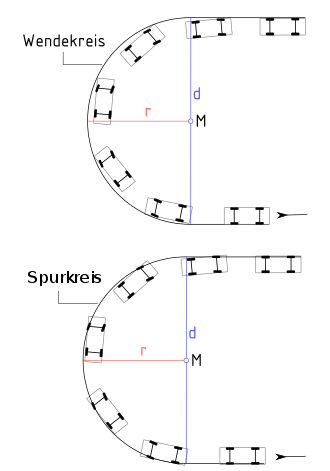Turning circle (vehicle)

The turning circle is the smallest circle (in relation to the parts of the vehicle that protrude furthest into the outside of the curve) in which a vehicle can make a circle with a full steering lock. As a parameter for vehicles, the turning circle diameter (also called turning circle for short) describes the diameter of this smallest turning circle. The turning radius is the radius of this circle, i.e. half the size of the diameter.
A related term is the track circle . This describes the circular path (track) of the wheel that is furthest outward when traveling in a circle . Analogous to the turning circle, the term track circle is also used as a parameter of vehicles and then describes the diameter of this circle. This is measured from the center of the tire.
The turning circle clearly indicates the diameter of a cylindrical wall within which a vehicle can just barely drive in a circle with a full steering lock. The track circle, on the other hand, indicates the diameter of the smallest circular disc on which a vehicle can just drive in a circle. Parts of the vehicle then protrude beyond the circular disk.
The turning circle diameter is always smaller than the turning circle diameter, since the tire (at least not its center) is not the most protruding part of the vehicle when cornering.
The turning circle diameters vary greatly depending on the type of vehicle. A smaller turning circle means better handiness, for example in urban areas . The typical turning circle of cars is approx. 10 m to 12 m (body turning circle). Buses - depending on the type and length between 18 m ( e.g. Citaro K or Lion's City M) and approx. 25 m (15 m buses, articulated buses 18.75 m or more in length) - and trucks, on the other hand, need a multiple of this Worth.
calculation
The circle diameter of the vehicle center of a single vehicle with front axle steering can be calculated using the single-track model as follows:
Here, D the diameter of the center of the vehicle, L the wheel base , and α of the steering angle of the wheels. The influence of the roll radius is neglected. When specifying the steering angle , the influence of the steering trapezoid should be taken into account, the wheels of an axle usually do not turn equally far (with single wheel steering).
The turning radius is half the turning diameter.
The turning radius is obtained by adding the body overhang to the turning radius, which can be calculated using trigonometric functions.
The turning circle diameter is twice the turning circle radius.
Situation in Germany
In Germany, § 32d StVZO prescribes "cornering properties" for vehicles and trailers. These implicitly include a limitation of the turning circle. Accordingly, vehicles must be able to drive a circle with a radius of 12.5 m, based on the front (rear-wheel steering, rear) extreme limit of the vehicle. In order to be able to meet this requirement for the radius , a vehicle must obviously have a (minimal) turning circle that is at most twice the diameter , i.e. 25 m .
However, this does not ensure that all vehicles can use all curves and roundabouts; the geometry of the drag curve is decisive for this. Road trains and EuroCombis (so-called "GigaLiner") can only meet the conditions of the BOKraft group if, in addition to the usual steering axle, other axles are automatically steered.
Remarks
From the clear interpretation of the turning circle with the help of an imaginary cylindrical wall, it becomes clear that the turning circle diameter of rigid vehicles without articulation, even with all-wheel steering and a maximum steering angle of 90 °, is always at least as large as the length of the vehicle diagonal (or, more generally, the largest dimension of the vehicle in the plane of rotation). In particular, there cannot be a turning circle of 0 m.
See also
Individual evidence
- ↑ Wissen.de on the subject of the tropics
- ↑ See Kemper: machinist for fire trucks . 1st edition. ecomed SECURITY, Landsberg / Lech 2009, ISBN 978-3-609-62012-1 , p. 36 .
- ↑ The main subject of the regulation, however, is that when driving in a circle inside a curve, a circular disk with a 5.3 m radius must not be passed over (so-called " BOKraft circle ").

